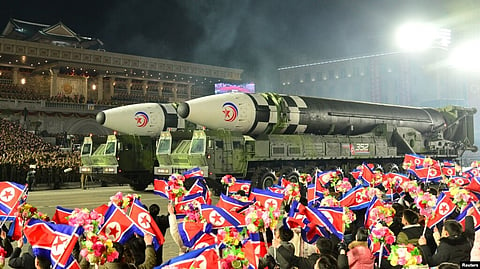
- Home
- न्यूजग्राम
- India
- World
- Politics
- Entertainment
- Culture
- Lifestyle
- Economy
- Sports
- Sp. Coverage
- Misc.
- NewsGram Exclusive
- Jobs / Internships

Missiles are displayed during a military parade to mark the 75th founding anniversary of North Korea's army, at Kim Il Sung Square in Pyongyang, North Korea Feb. 8, 2023. (North Korea's Korean Central News Agency via Reuters)
North Korean Military
A grand nighttime event in Pyongyang Wednesday parading military hardware featured the largest contingent of North Korean intercontinental ballistic missiles to date, including a handful believed to be mock-ups of nuclear-capable missiles that would run on solid-fuel engines.
Reporting on the military parade marking the 75th anniversary of the Korean People’s Army, North Korea’s Korean Central News Agency praised the ICBM display as a show of a “revolutionary development” of its defense power and its “tremendous nuclear attack capability.”
Eleven Hwasong-17 ICBMs were rolled out at Kim Il Sung Square, carried by 11-axle transporter erector launchers, according to images released by state media. They were followed by five smaller, previously unseen canisterized — in transportation containers — ICBMs that were not identified but believed by multiple analysts to be early versions of a solid-fuel ICBM Pyongyang has long aimed to develop.
“One ICBM launcher for every letter in the word ‘denuclearization.’ Coincidence?” asked Ankit Panda, a senior fellow at the Carnegie Endowment for International Peace, in a tweet. He raised concern that the sheer number of ICBMs — if capable — could overpower U.S. ground-based interceptors.
N. Korean leader Kim Jong Un and his daughter attend a photo session with the scientists, engineers and others involved in the test-fire of the new Hwasong-17 ICBM in this photo released Nov. 27, 2022 by N. Korea's KCNA via Reuters.
North Korean Military
The Hwasong-17 ICBM has been dubbed a “monster missile” for its hypothetical ability to reach the continental United States, carrying multiple nuclear warheads intended for multiple targets. Its first successful test was in November, which shot the missile on a vaulted trajectory, giving it an estimated flight distance of 15,000 kilometers.
North Koreans are known to be working on reentry technology, alongside a solid fuel engine — the latter of which would enable ICBMs preloaded with fuel, cutting the time from dispatch to launch, compared to their liquid-fueled counterparts.
Some Seoul-based analysts project Pyongyang could soon test the Hwasong-17 ICBM again — this time in a normalized, straightened trajectory — in what would be a highly inflammatory move for Washington.
“Our young regular armed forces developed into the most powerful entity, with a stockpile of overwhelming force, to completely suppress and crush imperialist tyranny,” the Korean Central News Agency said Thursday in its report on the parade referring to North Korea’s weaponized nuclear capability.
It also mentioned a new tactical nuclear weapons operation unit, which it said would fulfill “their strategic mission at any time loyal to the order of the leader only.”
Leader Kim Jong Un, taking in the military parade at a VIP box alongside his military top brass, joined by his wife and daughter, notably refrained from making an address.
Surprising silence
There had been expectations Kim Jong Un would use the occasion to send a vocal message to Washington and Seoul amid the allies’ reenergized combined military exercises as part of the U.S. pledge for extended deterrence. A U.S.-South Korea tabletop exercise, halted under the previous South Korean government of Moon Jae-in, will resume later this month, with a focus on a North Korea nuclear attack scenario, according to Seoul.
Last Thursday, in response to U.S. Defense Secretary Lloyd Austin’s South Korea visit earlier in the week, North Korea’s foreign ministry blasted the U.S. for reaching “an extreme red line,” criticizing a pledge for increased U.S. strategic asset deployments to the region. Its spokesperson warned any military action by Washington would be met with “the principle of ‘nuke for nuke and an all-out confrontation for an all-out confrontation.’”
“This time, Kim Jong Un let North Korea’s expanding tactical and long-range missile forces speak for themselves,” said Leif-Eric Easley, a professor at Ewha University in Seoul, on the absence of a speech. “Military parades largely serve to justify Kim’s policies to a domestic political audience. The message Pyongyang wants to send internationally, demonstrating its capabilities to deter and coerce, will likely come in the form of solid-fuel missile tests and detonation of a miniaturized nuclear device.”
New ICBM first impressions
Video of the nighttime military parade had not been aired by North Korea at the time of writing, and it will be some time before more is known about, in particular the new ICBM prototype unveiled in a cloud of suspense.
“Of interest in this military parade is that ‘hidden card’ that followed the Hwasong-17 on a nine-axle transporter erector launcher,” said Kim Dong-yup, professor at the University of North Korea Studies. “When we consider how North Korea has been presenting its new weapons, it does so first in a military parade then proceeds to develop and test it.”
Kim, the professor, noted the presumed solid-fuel ICBM could be a model of a forthcoming Pukguksong missile, the submarine-launched ballistic missile series, over the land-based Hwasong series. It could be less than a year before the world sees the new ballistic missile fly, he said, and by 2025, at the latest, before Kim Jong Un’s stated five-year plan for military modernization expires in 2026.
(SJ/VOA)
